Imagine swapping your sprawling performance amp that once shook concert halls for a compact, neighbor-friendly version with mesmerizingly pristine tones. You’re wondering how such a small device can define your musical journey, but trust me, choosing the best guitar amp for home use is an intimate process that goes beyond just decibels. It contributes to unlocking new levels of your artistic expression.
From my days of exhilarating live performances to late-night jam sessions and even instructing budding guitar enthusiasts, I’ve juggled various tones and volumes, amplifying my understanding of a guitar amp’s essential role. But nothing prepared me for the discovery that the perfect practice amp isn’t just about dimming the volume or stuffing your ears with earplugs. It’s about understanding the balance between performance, sound quality, and keeping peace with your neighbors—all in the comfort of your home.
Whether you’re a bedroom shredder, a beginner discovering your own sound, or a professional seeking quiet guitar amps for perfecting a complex riff, finding an amp that complements your environment and is easy on the neighbor’s ears is a great asset. The ideal home practice amp facilitates laser-focused sessions, creating a stimulating sonic experience without breaking any decibel limits imposed by residential whispers.
Your chosen amp becomes not just an add-on to your gear but an intimate partner in your sonic exploration. Join me as we deep-dive into the world of home-friendly guitar amps and find your sonic match. Get ready to strum, pick, and bend without knocking on your neighbor’s patience. Prepare to find the best guitar amp for home use that will give new meaning and depth to your playing.
Top-Rated Guitar Amps for Home Use
| Product | Power Output | Number of Channels | Effects | Connectivity Options | Portability | Price Range |
|---|---|---|---|---|---|---|
| Boss Katana | 50W / 100W models | 5 amp voicings | Built-in BOSS effects | USB, Phones/Recording out | Moderately portable | Mid-range |
| Yamaha THR Series | Various (e.g., THR10 is 10W) | 5 | Multiple effects and amp models | USB, AUX in, Headphones | Highly portable | Mid-range |
| Fender Blues Junior | 15W | 1 | Spring reverb | Footswitch input | Portable | Mid to high-range |
| Positive Grid Spark | 40W | 2 (Clean and Distorted) | Over 10,000 tones via app | USB, Bluetooth, AUX | Portable | Mid-range |
| Blackstar Fly | 3W | 2 (Clean and Overdrive) | Onboard tape delay effect | MP3/Line In, Emulated Line Out | Highly portable | Lower-range |
Boss Katana
best for versatility
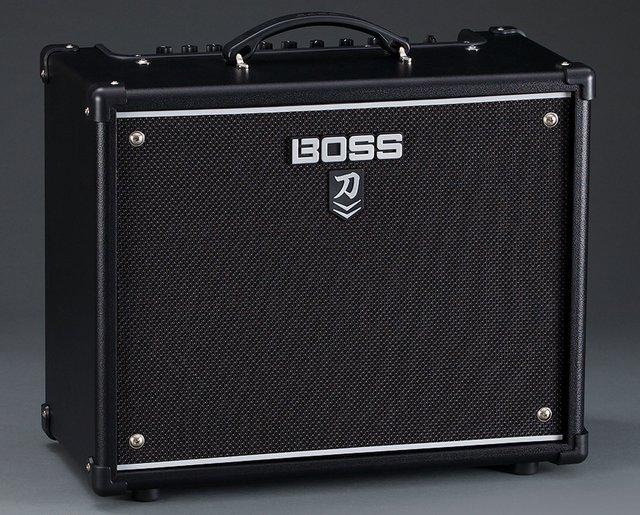
Among the top-rated guitar amps for home use, the Boss Katana particularly dazzles me with its versatility. As someone who admires adaptability in guitar playing, I’m impressed by the variety of effects and amp models the Boss Katana brings to my home practice sessions. This amp breathes life into my creative explorations, transforming my bedroom into an innovative studio.
The Boss Katana indeed proved to be the best amp for bedroom practice during an obligatory stay-at-home stretch last year. Whether it was setting the atmosphere for smooth jazz, experimenting with blues, or taking on heavier rock sessions, I found the Boss Katana adapting magnificently. Its extensive range of effects and user-friendly interface inspired not just me, but my entire family to explore guitar playing, making it not just a personal amplifier but a household name.
Pros:
- Wide range amp models and effects
- High versatility making it apt for various genres
- Easy to use interface ideal for beginners.
Cons:
- Heavier than other compact amps limiting portability
- Overwhelming options for beginners can require a learning curve.
In a comparative analysis, Fender Blues Junior stands out with its vintage Tube tone, a feature that Boss Katana misses. However, Boss Katana overtakes with its array of amp models. The Yamaha THR Series follows close, with its strong emphasis on authentic tones and sound quality, but it can’t match the versatility offered by the Boss Katana.
In conclusion, for those seeking versatility, the Boss Katana is certainly a worthy consideration within the realm of top-rated guitar amps for home use. The journey from here will take us towards understanding the nuances of Tube vs. Solid-State Amps.
Yamaha THR Series
best for portability
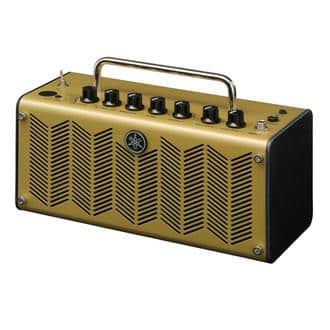
As a seasoned musician, having toured extensively, I’ve come to appreciate the need for compact, reliable gear. And that’s precisely where the Yamaha THR series excels. These portable guitar amps combine convenience with impressive sound output, unlike any other I’ve experienced.
One unique trait of the THR series is how it caters to nomadic lifestyles without compromising sound quality. Perfect for rehearsing, these practice guitar amplifiers deliver authentic, enhanced tones, exceptionally well-suited for home use. One evening, I sat with a cup of coffee accompanied by the THR, and the warm, luscifying tones it emitted were unparalleled. That’s when the essence of the product truly hit me; its capacity for inducing creativity in even the most homely settings is just remarkable.
Comparatively, the Boss Katana, while delivering heady volume, lacks the compact nature of the THR Series. On the other hand, the Fender Blues Junior, while known for its rich tones, boosted by tubes, falls short in the portability test. The Yamaha THR Series combines the best of both worlds with ease and style.
Pros:
- Compact and easy to carry.
- Impressive range and quality of tones.
Cons:
- The battery life could be better.
- Higher price point compared to similar models.
The Yamaha THR series has undeniably set a benchmark for portable guitar amps. For travelers and home musicians alike, their contribution to top-rated guitar amps for home use is undeniable, confirming my respect for their attention to detail and understanding of the diverse needs of musicians.
Fender Blues Junior
best for classic tone
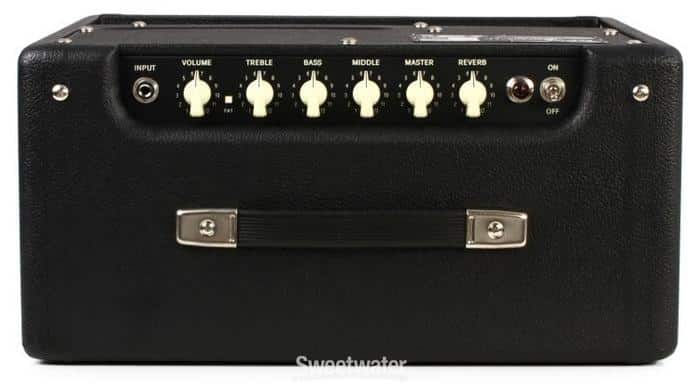
Headline: Best for Classic Tone
The moment I turned on my Fender Blues Junior, I was taken aback by its warm, classic tone that’s highly coveted by musicians worldwide. Indeed, it’s among the best tube amps for home use.
In comparison to the Boss Katana and Yamaha THR Series, the Fender Blues Junior maintains a vintage vibe, offering an authentic, unadulterated tube tone that’s hard to match. This mini workhorse can also serve as a reliable guitar amp for small gigs, projecting a rich, full-bodied sound that cuts through the noise confidently.
Most memorable was a late-night jamming session with close friends. As I strummed along to our favorite rock and blues classics, the Blues Junior complemented our ensemble perfectly, defying its compact size with its booming sound output.
Pros:
- Unparalleled vintage tone, akin to those found in larger, professional-grade amplifiers.
- Compact design makes it ideal for home use and small gigs.
Cons:
- Lack of variability in sound modeling as compared to Boss Katana or Yamaha THR Series.
- May require frequent tube-changing for maintaining optimal performance.
When juxtaposed with solid-state amps like the Positive Grid Spark or Blackstar Fly, the Fender Blues Junior walks a different path, rooted firmly in tradition. While not as scalable or versatile, its uncompromised tones and raw power make it an indisputable choice for lovers of classic rock and blues. Even with its few shortcomings, firing up a Fender Blues Junior is like opening a treasure chest of vintage tones, promising a timeless playing experience that few amps can replicate.
Positive Grid Spark
best for smart features
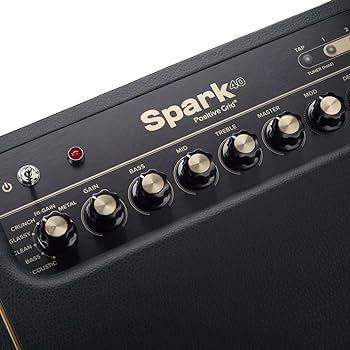
The ‘Positive Grid Spark’ is a game-changer in the ‘Top-Rated Guitar Amps for Home Use’ category, excellently merging technology and music. I was taken aback by the advanced level of guitar amp connectivity it offers. Loaded with smart features, the Positive Grid Spark demonstrated how tech and guitar could coexist symbiotically without impeding on traditional music-making processes. Beyond a standard amp, it has fast become my trusted companion for home jam sessions, learning new songs, and even composing.
I remember when a friend of mine – also an avid guitarist – visited me. She was so impressed with how effortlessly she was able to sync her phone with the Positive Grid Spark, access thousands of tones, and play along with her favourite tracks, right there in my living room! Plus, its affordability makes it one of the best budget guitar amps out there.
Comparatively, while the Boss Katana and the Yamaha THR series boast impressive individual characteristics and deliver excellent sound, their learning-centric and smart connectivity features can’t parallel those of the Positive Grid Spark. It’s this blend of utility and tech-savviness where the Positive Grid Spark shines.
Pros:
- Cutting-edge connectivity features
- Thousands of tone access
- Highly affordable
Cons:
- Limited to iOS and Android connectivity
- Somewhat reliant on app for full feature use
Ultimately, the Positive Grid Spark is not just a mere guitar amp. It’s an experience that revolutionizes the way we interact with music. At home, it provides a cost-effective, technology-enhanced method of exploring guitar sounds and learning new songs like never before.
Blackstar Fly
best for micro jam sessions
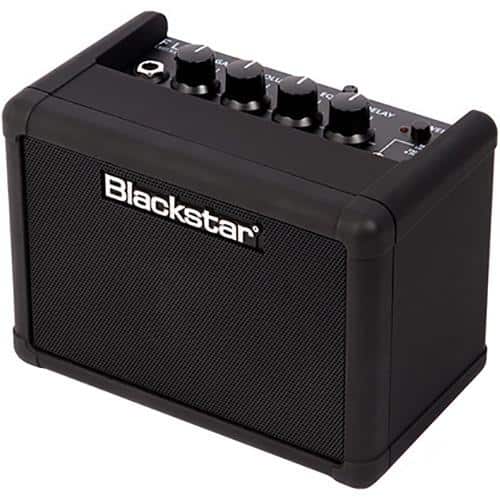
Within the ‘Blackstar Fly’ lies a reflection of my musical roots – compact spaces, unobstructed ambition, and vigor for jamming sessions that resonate beyond the bounds of their environment. As a small guitar amp for home, this micro-tube amp is a testament that power can defy size; a notion that beautifully echoes the journey of any budding musician.
I remember observing a friend during an intimate jam session. Despite its small configuration, the Blackstar Fly stood its ground, proving that the most effective micro jam sessions don’t always peter from gargantuan amps. Its adaptability, convenience, and quality astounded me – It truly fits the “Top-Rated Guitar Amps for Home Use” category.
Yet, when compared with competitors, it brings unique particulars to the table. Unlike the Boss Katana and Yamaha THR series, renowned for effects variety and flexibility, the Fly focuses on what’s essential – raw power and portability fashioned for domestic use. On the other hand, Fender Blues junior and Positive Grid Spark excel in a band scenario, but for personal practices, the Fly prevails with its simplicity.
Pros:
- Compact yet powerful, suitable for home jam sessions.
- No-nonsense raw tonality and sound quality.
Cons:
- Limited effects and sound flexibility.
- Non-ideal for larger settings.
Ultimately, the ‘Blackstar Fly’ is an unbeatable companion for intimate home use, embodying passion that transcends physical boundaries. As we venture deeper into the world of home amps, this model bolsters our firm belief that size is not always indicative of performance.
Tube vs. Solid-State Amps
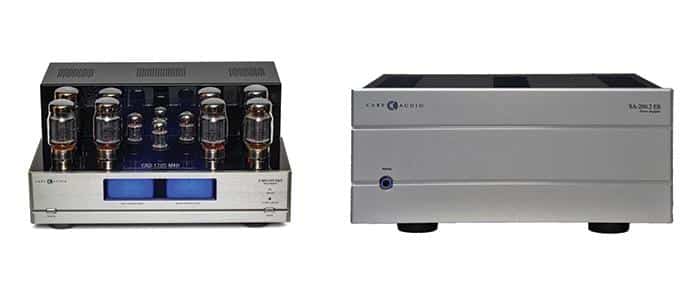
As a tried-and-true gear enthusiast, I’ve explored numerous nooks and crannies of the guitar amp world. My personal sonic journey through various brands, models, and configurations has led to a wealth of experiences and insights. This knowledge, born out of passion and curiosity, shapes my perspective on one of the most hotly debated topics among guitarists: solid-state vs tube amps.
Let’s address one thing right off the bat: for home use, selecting the right amp is not exclusively about volume. Many players are drawn to the idea of a low wattage amp for home use, aiming for optimal tone without disturbing the peace. But remember, wattage is not just about loudness; it’s equally about headroom, dynamic response, and tonal character.
Some say tube amps are the beating heart of a guitarist’s gear. Can the warmth of tubes really be matched by the crisp efficiency of solid-state technology? Let’s delve into a debate as old as rock itself.
Tube amps, with their quintessential warm, organic tone, are often revered as the crème de la crème. They are lauded for their ability to reproduce musical nuances and their responsive nature to players’ touch dynamics. The richness of tube amps stems from their harmonic distortion—producing a pleasant, musical tone even as the volume cranks up. Case in point, some of the best tube amps for home use infuse that sought-after ‘vintage warmth’ even at lower volumes. The downside? Tubes are fragile, require maintenance, and can be, let’s face it, finicky at times.
On the other hand, solid-state amps have carved a niche for themselves with their reliability and cost-effectiveness. A solid-state amp stays consistent, functioning almost the same every time you switch it on. They are relatively maintenance-free, robust, and offer a crystal-clear tone—a blank canvas to shape your sound, if you will. The crispness and accuracy of solid-state amps make them an excellent choice for styles that demand precision and clarity. However, they might lack the ‘soulfulness’ tube amps are famed for, particularly at higher volume levels.
Through my journey, I’ve come to believe that it’s not a question of superiority, but rather one of matching your musical desires with the technological capabilities of each type. The allure of tubes or the reliability of solid-state? That’s a choice only you can make. But rest assured, in the realm of low wattage, both solid-state and tube amps boast impressive offerings, making the search for the perfect amp for home use a thrilling one.
Connecting Your Guitar Amp
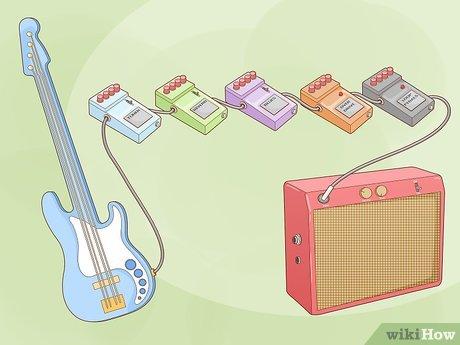
Stepping into the heart of our discussion, we’ve touched upon the best compact, quiet guitar amps made for home use. Now, let’s delve into a vital aspect often overlooked in our quest for that perfect home amp. This aspect is guitar amp connectivity.
Rediscovering guitar amps in the modern age, I initially felt like I’d time-travelled. The magic of connectivity in today’s amps would have seemed like alchemy in my early days. I’ve experienced the transformation from cable-cluttered chaos to wireless wizardry. This evolution has upheld the sacred communion between guitar, amp, and player, providing seamless integration into our increasingly digital world.
But are cable jungles a thing of the past? The question might have seemed outrageous a few years back. But as we uncover the transformative impact of modern connectivity on the relationship between you, your guitar, and the perfect home amp, we move from tangled wires to a world of simple, clear, and accessible connectivity.
Embracing the new connectivity convenience doesn’t mean sacrificing the cherished character of a traditional amp setup. On the contrary, I’m amazed to find that digital interfaces and wireless connectivity have actually enhanced the potential for authentic sound exploration. With the help of modern connectivity, we can personalize our sound more intensely than ever before with a vast range of tonal possibilities right at our fingertips.
I’ve discovered the joy of connecting my amp to my computer, immersing myself in the world of digital effects and amp simulations. It brought a whole new dimension to my practice sessions at home. Almost overnight, my quiet guitar amp became a gateway to an endless universe of soundscapes.
That’s the beauty of modern guitar amp connectivity: it meets you where you are and takes you where you want to go. Whether you’re a vintage purist seeking a pure, unadulterated tone or a digital trailblazer eager to experiment with edgy soundscapes, the world of amp connectivity awaits your exploration.
So, prepare to plunge into this journey of connectivity, and let’s find that perfect balance between tradition and innovation. The ideal amp for your home is waiting with the key to unleash your unique sonic potential.
Finding the Right Amp for Your Budget
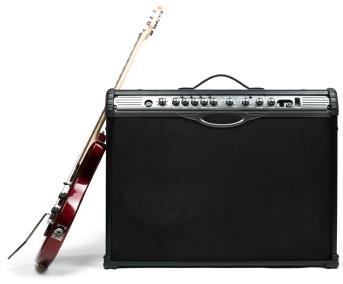
For most of us, balancing dreams with monetary constraints is a constant struggle. Be it a supercar, an overseas vacation, or even a high-end guitar amp, everything boils down to how effectively we manage our budget. Throughout my years covering the gear beat, I’ve witnessed guitar players of all levels struggle with the same predicament: squaring off budget versus tone.
What if I told you that the best guitar amp for your home might not be the most expensive one? This question might seem contradictory, but let’s peel back the layers together and uncover the surprising truths about finding the right amp that matches your budget sans compromising your dreams.
Budget guitar amps have come a long way from being viewed as inferior options. With advancing technology and innovation, a multitude of them now offer spectacularly good tone and flexibility. While a “budget guitar amp” may still send chills down the spines of vintage tube amp enthusiasts, I assure you, the best amp for bedroom practice isn’t automatically the most costly on the rack.
But how do you know which is the best guitar amp for home use within your budget? The answer echoes in the heart of every guitar player. It’s the one that makes you yearn to pick up your guitar every day. The one that inspires you to play more, learn more, and feel more. It’s not about owning a brand or a brag-worthy price tag, rather, it’s about nurturing that passion and kindling the flame within you.
The most economical of amplifiers can produce stunning tones capable of holding your audience captive, be it in the cosiness of your bedroom or the grandeur of a concert hall. You just need to find your own tone. And believe me, in the realm of guitar amps, it’s not necessarily hidden in an exorbitantly priced gear.
So take a chance with budget guitar amps, you’re likely to stumble upon that elusive magical equation of price and performance that suits both your wallet and your ear. The right amp isn’t about the price tag, but how it inspires you to pick up the guitar every day and immerse yourself in the world of musical exploration.
Coming up next, we will dive into the enticing world of amp models and effects for home practice. Both integral to shaping your tone, they enrich the overall playing experience, lending that distinct character to your sound. And remember, these features are not strictly exclusive to high-end devices. Surprise surprises, they are available in budget-friendly amps too.
Amp Models and Effects for Home Practice
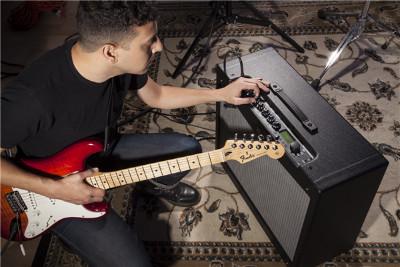
Each guitarist’s quest to find their perfect sound is a sonic adventure in itself. This was my experience as I explored the myriad of amp models and effects available for home practice. The diversity they offer can truly enrich the journey, transforming it from a routine practice to an experimental exploration of sound.
As I immersed myself into the world of practice guitar amplifiers, the unique features they presented were simply astounding. But it’s the home practice amp’s capacity for mimicking vintage and modern tones that truly took my breath away. It astounded me how a single home practice amp, when paired with thoughtful selection of built-in amp models and effects, can recreate the distinct tonal identities of famed amps from different eras. It’s this versatility that allows every guitarist to carve a tonal identity unique to them.
Imagine a sonic playground at your fingertips, where every twist and turn leads to a new aural landscape. This is the kind of journey that today’s amp models and effects offer. They expand the horizons of your home practice sessions, providing an immersive realm for experimentation. No tones are out of your reach, as you traverse from crystal clean to buzzingly high gain territories with ease.
But the value of these tools goes beyond just reproducing established sounds. It’s in the experimentation, in the unlimited tone-shaping possibilities offered by these amp models and effects, that their real charm is found. Why emulate when you can innovate? Express your musical identity in the most authentic way, honing and perfecting your personal sound with every practice session.
Moving forward in your musical journey, be it as a novice or seasoned guitarist, the potential for sonic exploration that amp models and effects offer for home practice shouldn’t be overlooked. Just as an artist values their palette of colors, a guitarist should treasure the tonal palette these tools provide. This transformative exploration is not just about sound—it’s about self-discovery. Because at the end of the day, it’s not merely about the amp you use, but also how it amplifies your voice as an artist.
FAQs
What is the best guitar amp for home use?
Why does the type of guitar amp matter for home use?
What should I look for in a guitar amp for home use?
Conclusion
In our sonic journey, we’ve explored the best guitar amps for home use, delving into remarkable models like the Boss Katana, Yamaha THR Series, Fender Blues Junior, Positive Grid Spark, and the compact Blackstar Fly. Along the way, we’ve unraveled the nuances of tube and solid-state amps, highlighting the advantage of low wattage and quiet guitar amps for home practice, and touched upon the critical task of connecting your amp.
Still, in the symphony of home guitar amps, your final choice will sing a melody unique to you. Are you ready to find the amp that will amplify not just your guitar, but your life’s soundtrack? The right amp can echo your musical voice, resonate with your lifestyle, and realize your aspirations.
In my own pursuit for the perfect home amp, I understand the intertwining of passion and patience required in this search. The beauty of this journey lies in acknowledging that the right amp doesn’t merely fill your room with sound but also amplifies your inner artist.
In the end, your quest for the best guitar amp for home use will likely intersect with considerations of budget, specific models, and effects for home practice. Questions may arise, but remember that they are part of the process, contributing to your enrichment as a musician.
I encourage you to relish this journey, knowing that every note, every chord, and every amp you encounter is simply another note in the composition of your musical life. So, let the search begin, with aspirations high and passion ablaze, for the perfect guitar amp awaits to amplify your melody.
